Z-Codes are three digit codes formed of letters (and always start with "Z", hence the name) to facilitate quick communications, especially when using morse code (and are used similarily to the civil Q-Codes). They are called "Operating Signals".
The Z-Code was originally developed as a service code by Cable & Wireless Ltd. for usage in the commercial communications business. NATO military Z-signals are completely different from the old Cable & Wireless codes.
The NATO military Z-signals, ZAA-ZXZ, are defined in ACP 131 and are in use by the whole Alliance. The series ZYA-ZZZ is reserved for the temporary or permanent assignment of meanings on an intra-military basis by any nation, service or command (and hence can differ for every nation).
I have condensed the AACP 131 manual into just the basic instructions and added a facsimile list of the ZAA-ZXZ Operating Signals, when you have gone through them you will hopefully understand the following (solution at the bottom of this post):
ZUC rattler users ZUI read ZDA ZCZ1 ZLA1 INT ZBK ZAL 0500Z sleep ZTL
Rattler, out.
How to use thema. Action Z signals ordering or indicating that an action is to be taken (a change of frequency, for example) will be answered before the action is taken, unless the "Broadcast" method is used or the station ordering or indicating the action has indicated that an answer is not required.
b. Affirmatives or Negatives. Operating signals, as appropriate, will be used by allied military stations to convey an affirmative or negative sense to allied military stations by using the appropriate Z signal:
Examples (of replies):
ZOE Means: (Yes) Give me your message. I will dispose of it.
NOTE: In addition to the above, replies to questions from military stations may be made by using ZUE meaning Affirmative (Yes) or ZUG meaning Negative (No).
c. Blank Spaces. Blank spaces in the meanings of Z signals
must be completed, in the order in which they appear; however,
blank spaces enclosed in parentheses normally
will be completed on an optional basis only.
Examples:
(1) ZOH Bf2 350 means: "Send message for Bf2 on 350 kHz". (The meaning assigned to ZOE is "Send message for ... on ... kHz"; therefore, as these blank spaces are not included in parentheses, all are completed, in the order in which they appear).
(2) ZKO BG2 means: "I have handed over guard to BG2". (The meaning assigned to ZKO is "I have handed over guard (to...) (on...kHz (or MHz)) (serial number of last message received was...)"; however, in this example, the user elected to complete only one of the blank spaces enclosed in parentheses, the first one).
d. Call SignsNormally call signs will
follow the Z signal to which they refer; however, they also may precede the operating signal for separation or clarity.
e. Frequencies(1) When the meaning of a Z signal includes the expression "on... kHz (or MHz)", the figures used
alone (not supplemented by an abbreviation) always will indicate the frequency in
kilohertz. To indicate the frequency in megahertz, the figures will be supplemented by the abbreviation "MHz".
(2) Provided that no confusion can arise, in those Z signals whose meaning includes the expression "on...kHz (or MHz)", the circuit designator or other disguised reference, if available, will be used in place of the actual frequency.
(3) Although not provided for in the meaning of a Z signal, a frequency may be used with any such operating signal by adding figures and the appropriate abbreviation ("kHz" or "MHz").
f. Numbered AlternatesZ signals with numbered alternate meanings will be followed, without spacing, by the appropriate number to indicate the meaning intended.
Example:
ZAP5 means: Work single sideband. (as ZAP has the following numbered alternate meanings - "Work...(1. simplex; 2. duplex; 3. diplex;
4. multiplex; 5. single sideband).")
g. Plain Language Plain unabbreviated language is authorized for use to complete or amplify the meaning of operating signals only when no other approved method will do.
h. Questions Operating signals, as appropriate, will be used by allied military stations to ask questions if military stations, by inserting the prosign INT before the Z signal to which it refers.
Examples:
INT ZDJ means: How many groups does your message contain?
i. Security Operating signals possess no security. They must be regarded as the equivalent of plain language.
j. Separation The separative sign (prosign II, written as a short dash) may be used to separate Z signals when desired.
k. Time Groups Time groups (including date-time groups) used with Z signals always will be followed, without spacing, by a time zone suffix letter. Although not provided for in the meaning of a Z signal, a time group (including date-time group) may be used with any such operating signal.
l. Units of Measurement When units of measurement are desired for use which differ from those in the meaning of an operating signal, an appropriate abbreviation will be used.
List of the Z Operating Signals as used by NATO:
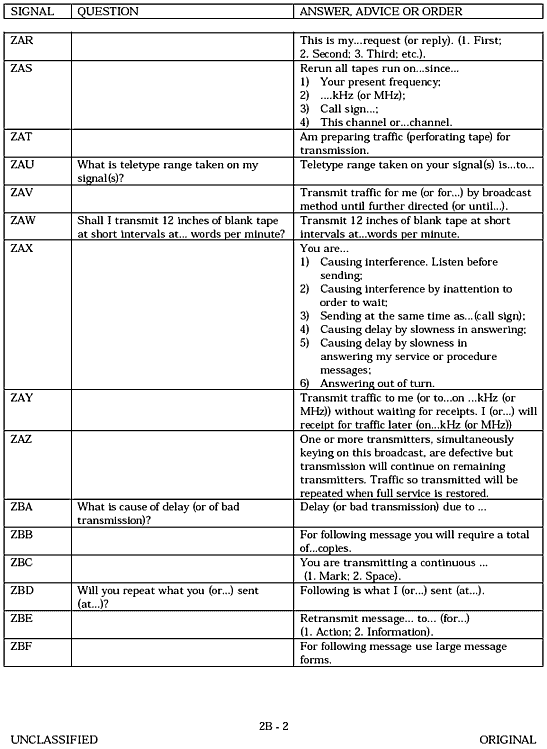
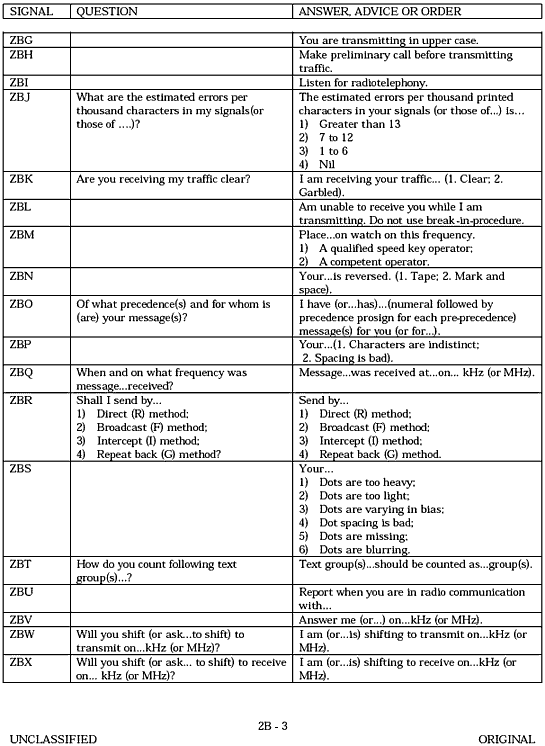
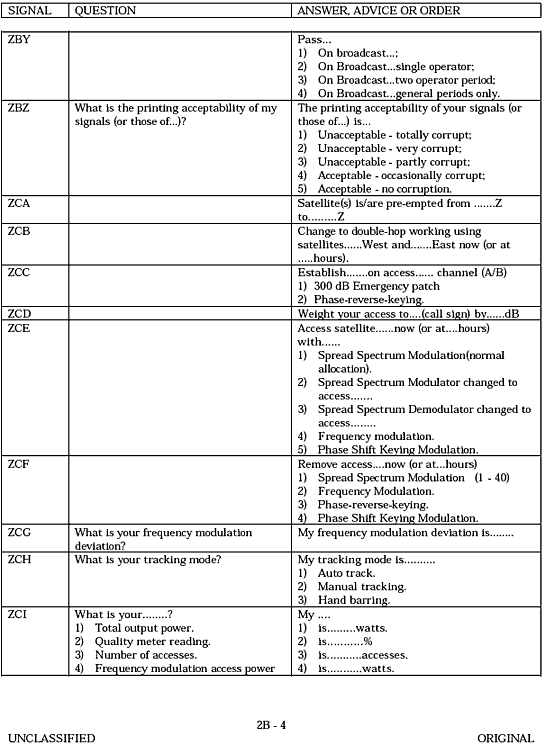
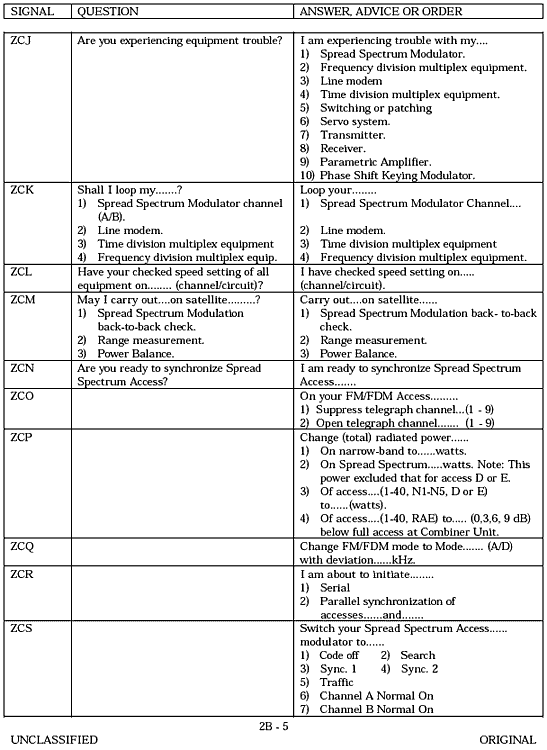
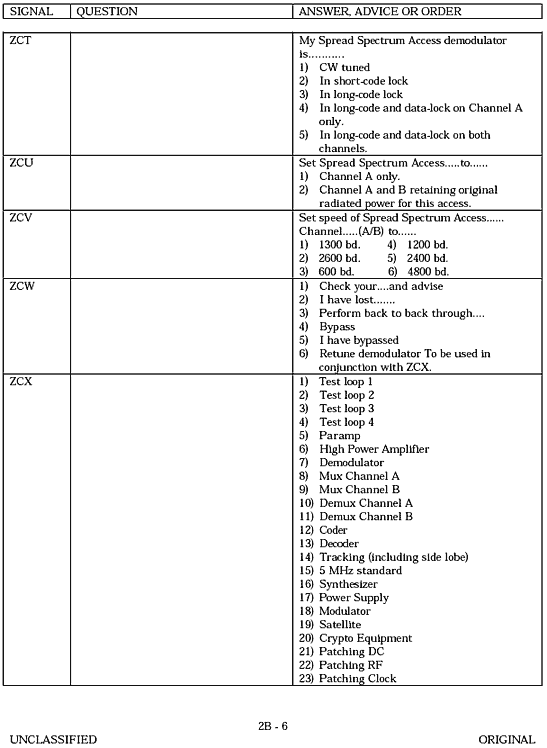

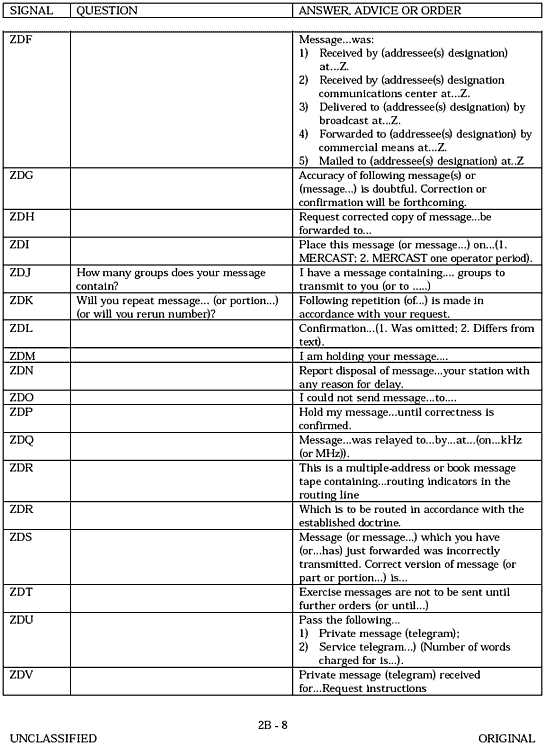

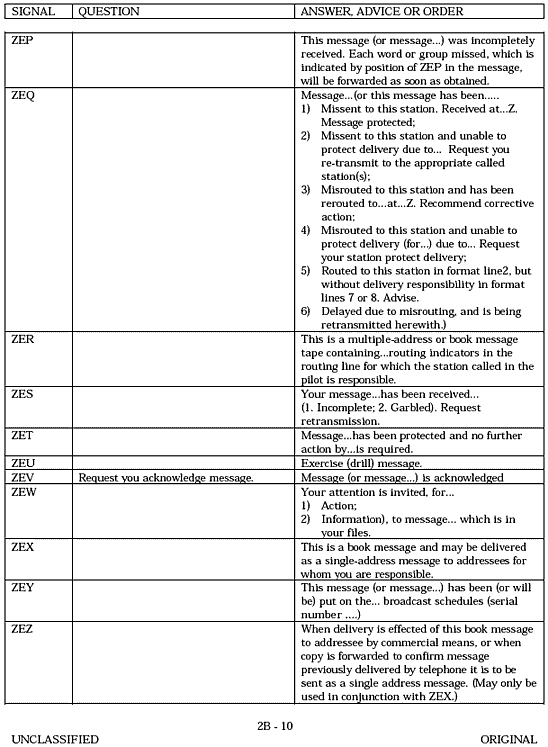
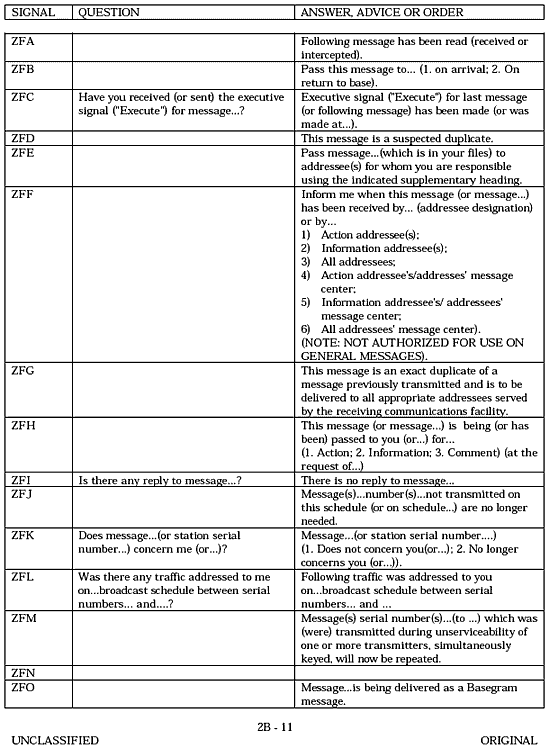




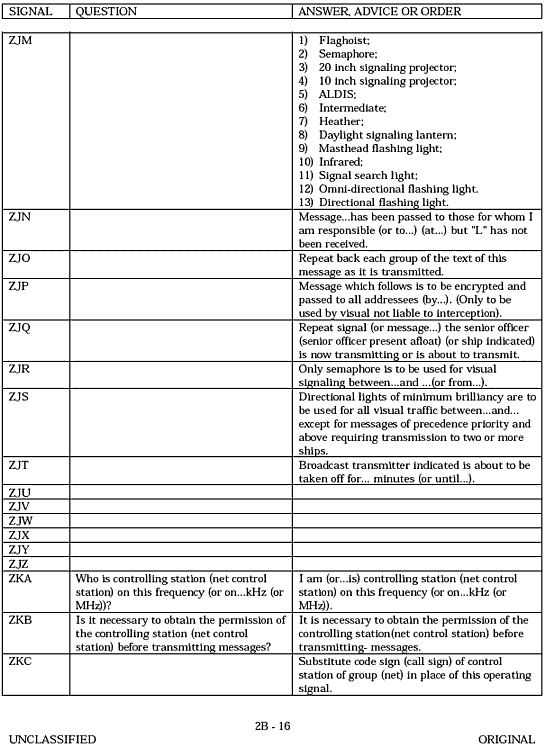




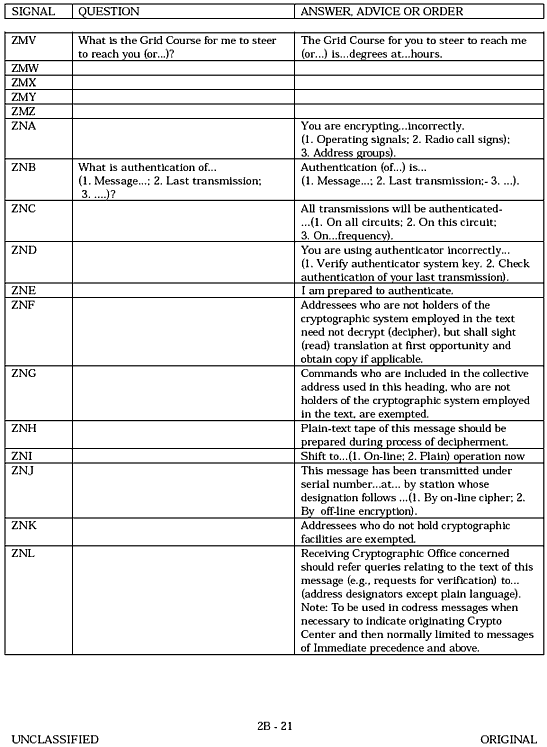










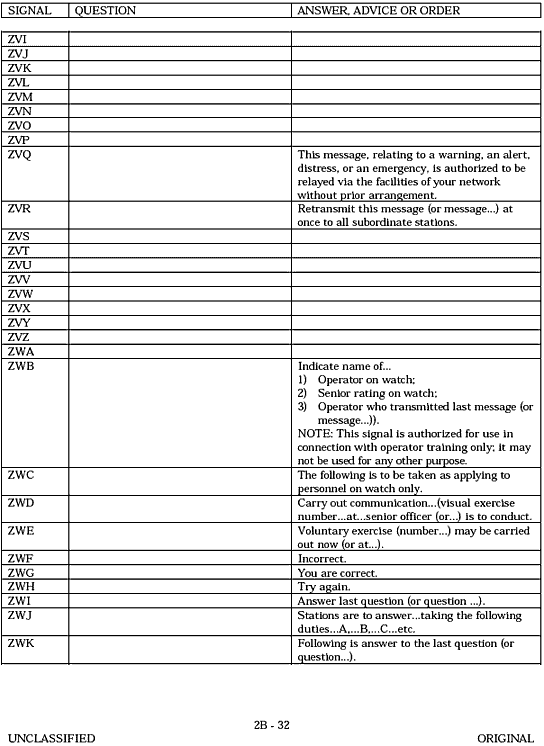

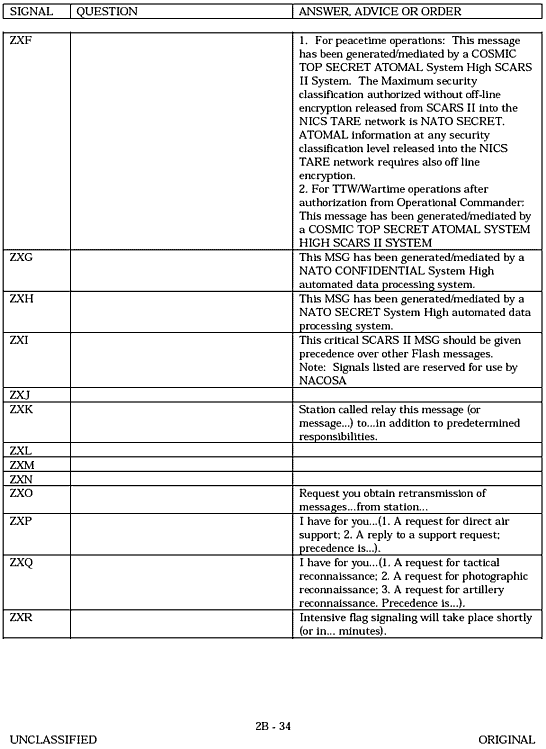
 Solution
Solution to the coded message from above:
ZUC rattler users ZUI read ZDA ZCZ1 ZLA1 INT ZBK ZAL 0500Z sleep ZTL
would translate to:
From Rattler to users. Your attention is invited to read. I have a message for you. Coded. I have pictures of the following type to transmit: Photographs. Are you receiving my traffic clear? I am closing down until 0500Z due to sleep. I am about to disconnect.











